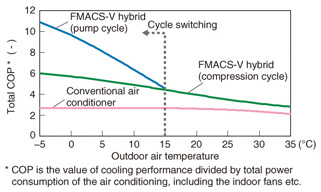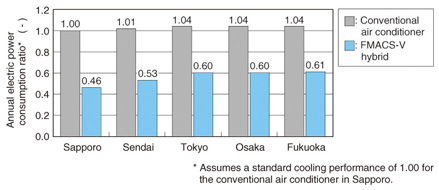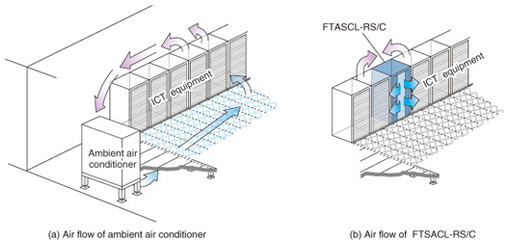 |
|||||||
|
|
|||||||
|
Feature Articles: Current Status of Technology Development Toward Energy-saving––For Continuous Telecommunications Infrastructure Connections 24/7 Vol. 12, No. 3, pp. 19–24, Mar. 2014. https://doi.org/10.53829/ntr201403fa3 Energy-saving Technology of Air-conditioning Systems for DatacentersAbstractThis article describes the features of two air-conditioning systems for datacenters developed by NTT Facilities. One is the FMACS-V (facilities multiunit air conditioning system-5th generation) hybrid, which received the 2012 Technology Award by the Japan Society of Mechanical Engineers. The other is the FTASCL-RS/C (facilities task cooler rack-shaped/compressor type), which received the 2012 Technology Prize from the Japan Society of Refrigerating and Air Conditioning Engineers. An evaluation of the FMACS-V hybrid operated by NTT EAST is also briefly described. Keywords: datacenter, free cooling, packaged air conditioner 1. IntroductionIn recent years, the use of servers and other information and communications technology (ICT) equipment has spread widely in our society, and their importance as a social infrastructure has been increasing. However, the operation of ICT equipment generates a large amount of heat and requires year-round air conditioning, so there is a strong demand for reduced power consumption of air conditioning systems. When the air conditioning is interrupted, the temperature around the ICT equipment rises, and in the worst case, operation of the ICT equipment must be stopped. Such stoppages may affect services, so the air conditioning system must be highly reliable. NTT Facilities has been developing ICT air conditioning technology to both reduce power consumption and increase reliability for over 30 years, contributing to the reduction of power consumption by the NTT Group and other industry enterprises. Commercial air conditioning solutions that are based on the developed technology are divided into air conditioning systems and air flow control technology for efficiently distributing the cool air supplied by the air conditioning systems to cool ICT equipment. The air conditioning systems that we have already developed are the floor-mounted FMACS (facilities multiunit air conditioning system), the rack-mounted FTASCL-RS/C (facilities task cooler rack-shaped/compressor type) (Fig. 1(a)), and the ceiling-mounted FTASCL-CM/C. Currently, the fifth-generation FMACS-V has been introduced, and there is a slim space-saving model and an indirect outdoor air cooling type hybrid model (Fig. 1(b)) in addition to the standard model. An example of air flow control technology is aisle capping (Fig. 1(c)), in which the path of the cool air supplied to the ICT equipment from a raised floor (cold aisle) is compartmented to physically separate the low-temperature air supplied to the ICT equipment from the high-temperature exhaust air, thus achieving efficient cooling.
The developed air conditioning technology has been well-received at conferences for its high energy-saving capabilities. In 2012, the FMACS-V hybrid*1 floor-mounted air conditioner for ICT equipment, which also uses indirect outdoor air cooling, received the Technology Award from the Japan Society of Mechanical Engineers*2, and the FTASCL-RS/C rack-mounted air conditioner for ICT equipment received the Technology Prize from the Japan Society of Refrigerating and Air Conditioning Engineers*3.
2. FMACS-V hybridThe FMACS-V hybrid has a simple system configuration in which only a refrigerant pump is added to a conventional compressor-equipped air conditioner (Fig. 2(a)) for cooling with outdoor air. The system automatically switches operating cycles according to the outdoor air temperature. In seasons when the outdoor air temperature is low, the system operates in the pump cycle using the refrigerant pump (Fig. 2(b)); in seasons when the outdoor air temperature is high, the system operates in the compression cycle using the compressor (Fig. 2(c)). The refrigerant pump consumes only about one-eighth the power consumed by the compressor, and therefore, operation in the pump cycle greatly reduces the annual energy consumption.
The air conditioning system in datacenters is operated throughout the year, so the effective use of low-temperature outdoor air for cooling in the cold seasons is important in reducing the annual power consumption. Low-temperature outdoor air can be used in two ways. One is direct outdoor air cooling, in which outdoor air is brought into the building directly; the other is indirect outdoor air cooling, in which a heat exchanger or other means is used. Operation using direct outdoor air cooling alone throughout the year is difficult in Japan, so it is generally used together with other air conditioning systems that have heaters. That, however, increases construction costs because of the redundancy in air conditioning facilities. Another problem is the reduction in indoor air quality that results from introducing a large amount of outdoor air directly, and there is concern for the effect this may have on the ICT equipment. To avert the problems that accompany direct outdoor air cooling, we adopted the indirect outdoor air cooling method and developed an air conditioning system that can operate in a pump cycle using a pump to circulate the refrigerant. That system enables switching to outdoor air cooling operation by simply switching the pipe flow path. Moreover, it does not require an opening in the exterior wall of the building for drawing in outdoor air, so it is relatively easy to introduce in existing structures. The effect on indoor air is the same as for conventional air conditioners. Problems with breakdowns in refrigerant pumping had previously prevented its application to commercial products. We solved that problem by developing a new pump mechanism and control system that enable safe operation and successful commercialization. 2.1 Field evaluation of the FMACS-V hybridDevelopment of the air conditioner included verification in a test room, but we also installed the system in an actual NTT EAST datacenter located in Hokkaido for further testing. That datacenter is actively adopting technology for reducing power consumption in order to reduce the burden on the environment. As described later in this article, the energy-saving effect of this air conditioning system is higher in regions where the outdoor air temperature is low throughout the year. We therefore took advantage of the cool climate of Hokkaido to evaluate the effect of this system on reducing power consumption. The arrangement of the air conditioning system units is illustrated in Fig. 3. The indoor units are placed in machine rooms adjacent to the server room, and the outdoor unit and pump unit are placed in an outdoor space on the roof of the building immediately above one of the machine rooms.
The indoor and outdoor air temperatures for the period for which the calculations were performed are shown in Fig. 4. The average indoor temperature was 23°C, and the range over the entire year was from 20°C to 25°C, which is suitable for the operation of ICT equipment. The result was a 46% reduction in power consumption compared to an ordinary air conditioning system. However, the air conditioning load was a low 40% in the period for which the calculations were done, so we expect that the energy-saving effect would be higher if the amount of generated heat and the air conditioning load were higher.
NTT EAST has continued to use this system at their Hokkaido datacenter even though the evaluation period has ended. They intend to continue their efforts to reduce power consumption at this datacenter by using this system when they expand the air conditioning system in the future. 2.2 Effects of reducing energy consumptionThe relationship between the air conditioning efficiency of the FMACS-V hybrid system and the outdoor air temperature is shown in Fig. 5. We can see a striking increase in efficiency from operation in the pump cycle compared to that in the compression cycle. That is to say, a longer pump cycle operation results in a greater reduction of power consumption, so the energy-saving effect will be greater in regions where the outdoor air temperature is low throughout the year. The annual power consumption ratios for an ordinary computer air conditioning system and for the FMACS-V hybrid system are compared in Fig. 6. We can see from the figure that the maximum reduction in power consumption is 54% for Sapporo but only 42% for Tokyo. These results show that we can expect our system to contribute greatly to reducing the amount of power used by air conditioning systems.
2.3 Expansion of the FMACS-V hybrid lineupCurrently, the FMACS-V indirect outdoor air cooling hybrid system is being developed as the L model for medium-to-large office buildings and datacenters (rated cooling power of 45 kW). To further expand the range of system applications, we will later move forward with development of an M model (rated cooling power of 20 kW) that has a smaller cooling capacity for introduction in small office buildings and server rooms. Adding the FMACS-V hybrid (M) to the lineup will make it possible to meet a broader range of customer needs and to further contribute to energy efficiency. 3. FTASCL-RS/CThe FTASCL-RS/C is an indoor air conditioner than can be mounted on racks in the same way as ICT equipment. With the conventional air flow method, a large volume of air has to be moved from a wall-mounted air conditioner (also called ambient air conditioners) to distant ICT equipment via a raised floor (Fig. 7(a)). With, rack-mounted air conditioners, however, the air conditioners can be placed near ICT equipment that produces large amounts of heat to take air in from the back and push air out from the front (Fig. 7(b)). This reduces the distance the air travels and the power consumed by the fan operation. Also, highly efficient operation is possible because the rack-mounted air conditioner can collect hot air (30–40°C) directly from the hot aisle (the aisle into which the hot exhaust from the ICT equipment flows).
With an air conditioning system that uses only ambient air conditioners, the cool air supplied from vent panels in the cold aisle may be insufficient, particularly in regions of high heat generation density, and hot air pockets can form from recirculation of hot exhaust air from the hot aisle to the cold aisle. That makes it difficult to maintain the prescribed temperature for air taken into the ICT equipment. With ambient air conditioners, it is therefore necessary to lower the indoor temperature setting for the entire room in order to maintain the proper ICT equipment air intake temperature. Consequently, it is often necessary to deal with excessive air flow, and operation becomes inefficient. Such problems can be solved by placing rack-mounted air conditioners near the ICT equipment. Supplementing the cool air supply with rack-mounted air conditioners makes it possible to set the ambient air conditioner temperature and air flow rate to reasonable levels and achieve efficient operation. Moreover, because the rack-mounted air conditioner vents cool air directly into the cold aisle, it is highly compatible with aisle capping. An air conditioning system that combines rack-mounted air conditioners with aisle capping can reduce the annual power consumption by 58% compared to a conventional air conditioning system that comprises an ordinary air conditioner used together with a raised floor configuration. 4. ConclusionThis article presented the award-winning FMACS-V Hybrid system, an indirect outdoor air cooling hybrid air conditioning system for ICT equipment, and the FTASCL-RS/C rack-mounted air conditioner for ICT equipment; both are highly reliable and highly energy-efficient air conditioning systems for datacenters. We will continue to expand the product lineup to further contribute to reducing power consumption in the ICT field. |
|||||||
















